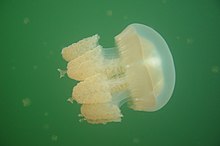| Golden jellyfish | |
|---|---|

| |
| Scientific classification | |
| Domain: | Eukaryota |
| Kingdom: | Animalia |
| Phylum: | Cnidaria |
| Class: | Scyphozoa |
| Order: | Rhizostomeae |
| Family: | Mastigiidae |
| Genus: | Mastigias |
| Species: | |
| Subspecies: | M. p. etpisoni
|
| Trinomial name | |
| Mastigias papua etpisoni Dawson, 2005
| |
The golden jellyfish (Mastigias papua cf. etpisoni[1]) is a subspecies of spotted jellyfish (Mastigias papua) that inhabits Jellyfish Lake on Eil Malk island in Palau in the western Pacific Ocean.[2] Like the nominate subspecies, it derives part of its nutrition from symbiotic algae (Zooxanthellae) that live in their tissues and part of their nutrition from captured zooplankton.[3]
The golden jellyfish is morphologically, physiologically, and behaviourally distinct from the spotted jellyfish. It was described as a separate subspecies in 2011, together with four other new subspecies inhabiting nearby marine lakes. The species identification is uncertain (denoted by cf. in the name) because the individuals local to Palauan lagoons may be only one of several cryptic species that make up the M. papua group. It is distinguished by the almost complete loss of spots on the exumbrella and the almost complete loss of their clubs, an appendage attached to the oral arms.[4]
- ^ "Golden Jellyfish | National Geographic". Animals. November 9, 2010. Archived from the original on March 15, 2021.
- ^ Dawson, Mike N; Martin, Laura E; Lolita K, Lolita K.; Penland (May 2001). "Jellyfish swarms, tourists, and the Christ-child". Hydrobiologia. 451. Springer Netherlands: 131–144. doi:10.1023/A:1011868925383. ISBN 978-0-7923-6964-6. S2CID 1679552.
- ^ Dawson, Michael N (2000). "Variegated mesocosms as alternatives to shore-based planktonkreisels: notes on the husbandry of jellyfish from marine lakes". Journal of Plankton Research. 22 (9): 1673–1682. doi:10.1093/plankt/22.9.1673.
- ^ Dawson, Michael N (2005). "Five new subspecies of Mastigias (Scyphozoa: Rhizostomeae: Mastigiidae) from marine lakes, Palau, Micronesia" (PDF). Journal of the Marine Biological Association of the United Kingdom. 85 (3): 679–694. doi:10.1017/S0025315405011604. S2CID 13572718. Archived from the original (PDF) on 2006-09-05.